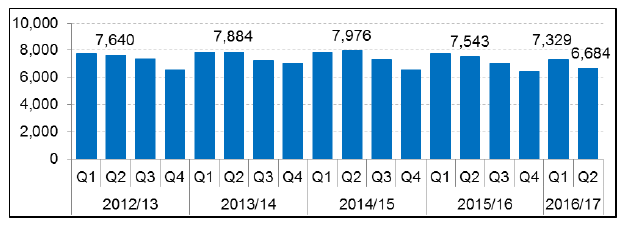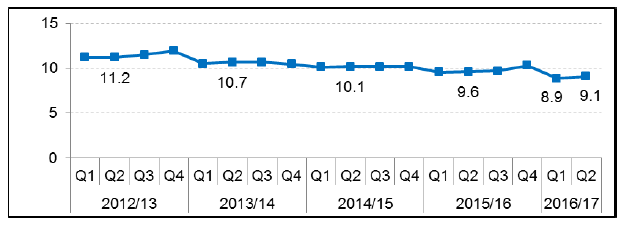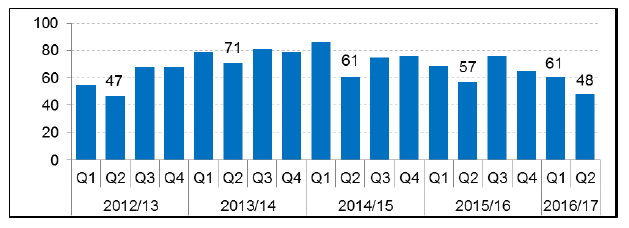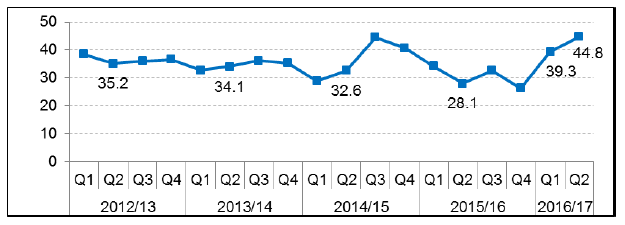Planning performance statistics: second quarter, 2016-2017
This report presents the latest summary statistics on planning decision-making and timescales for July to September 2016 (Quarter 2).
Planning Performance Statistics, 2016/17, Q2
This report presents the latest summary statistics on planning decision-making and timescales for July to September 2016 (Quarter 2), as well as historic data going back to quarter one of 2012/13. It is based on data collected by the Scottish Government from Local and Planning Authorities as part of the Planning Performance Framework (introduced in 2012).
Applications for Local Developments (excludes legacy cases)
There were 6,684 applications for local developments decided in quarter two of 2016/17, 645 (9%) fewer than the 7,329 decisions in the previous quarter, and 859 (11%) fewer applications than the 7,543 decisions in quarter two of 2015/16. The average decision time for these 6,684 local developments was 9.1 weeks, slower by more than one day compared to the previous quarter (8.9 weeks), but quicker than the equivalent quarter two figures in each of the previous four years.
Chart 1: Applications for Local Developments: Number of decisions

Chart 2: Applications for Local Developments: Average decision time (weeks)

In addition, there were 318 local development applications concluded in quarter two of 2016/17 that were subject to separate processing agreements and are not included in average time calculations. 83% of these applications met the agreed timescales that had been set between developers and local authorities.
Local developments include applications for household extensions and loft conversions etc., smaller housing and retail developments, as well as various other types of local developments.
These figures exclude pre 3rd August 2009 legacy cases. Information on applications that include legacy cases is included in the following chapters.
Applications for Major Developments (excludes legacy cases)
For applications subject to average time calculations there were 48 major developments decided in quarter two of 2016/17, 13 (21%) less than the 61 decisions in the previous quarter, and 9 (16%) less than the 57 decisions in the equivalent quarter of 2015/16. The average decision time for these 48 major developments was 44.8 weeks, more than 5 weeks slower than the previous quarter (39.3 weeks) and the slowest average decision time since the start of this data collection in quarter one of 2012/13.
Chart 3: Applications for Major Developments: Number of decisions

Chart 4: Applications for Major Developments: Average decision time (weeks)

It should be noted that the average time figure of 44.8 weeks has been influenced by two very lengthy decision times (3.8 years and 5.4 years). Without these two applications the average decision time would be 36.2 weeks.
Further information on the distribution of decision times for major development applications is given in Annex A.
In addition there were a further 17 major development applications concluded in quarter two of 2016/17 that were subject to separate processing agreements. 100% of these applications met agreed timescales that had been set between developers and local authorities. Applications subject to processing agreements are not included in average time calculations. For the most recent quarter, major applications with processing agreements accounted for more than a quarter of the decisions made for all major developments. When processing agreements are included there is an overall decrease of 29% in the total number of decisions made for major applications from 91 in quarter one to 65 in quarter two of 2016/17.
Major developments include applications for 50 or more homes, as well as certain waste, water, transport and energy-related developments, larger retail developments, and other types of major developments. Typically there are only a small number of decisions made for major development each quarter and therefore average decision times are likely to be volatile.
Some of the changes over time seen in the decision time charts above may be partly due to improvements in recording of periods of inaction by the applicant. This is referred to as "stopping the clock". See Section 1.6 and Section 9 for further details.
These figures exclude pre 3rd August 2009 legacy cases. Information on applications that include legacy cases is included in the following chapters.
Contact
There is a problem
Thanks for your feedback